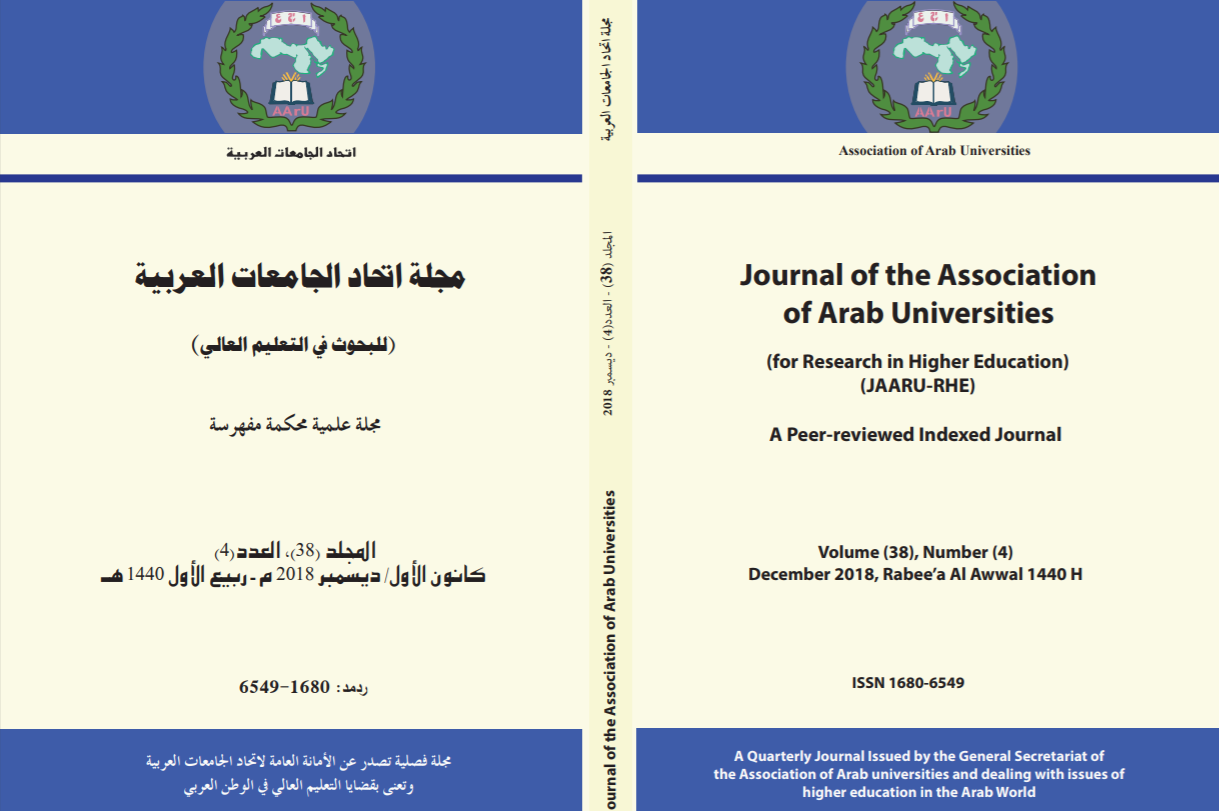Journal of the Association of Arab Universities for Research in Higher Education (مجلة اتحاد الجامعات العربية (للبحوث في التعليم العالي

Abstract
هدف المقال إلى قياس أثر استراتيجيتي الفصول المعكوسة التشاركية (التقدمية والرجعية) على التحصيل الدراسي وتنمية مهارات التفكير الناقد لطلبة الصف السادس في مادة التربية المهنية في لواء قصبة عمان، تمّ بناء أداتي الدراسة المكونة من اختبار تحصيلي، واختبار مهارات التفكير الناقد، وتمّ التأكد من صدقهما وثباتهما، اعتمدت الدراسة على المنهج شبه التجريبي، وتكوّنت عينة الدارسة من (90) طالبة من طالبات الصف السادس الأساسي، تمّ سحب العينة بالطريقة القصديّة من مدارس الحصاد التربوي، وتمّ توزيعهم بشكل عشوائي على ثلاثة مجموعات، أظهرت نتائج الدراسة وجود فروق ذات دلالة إحصائية (α =0.05) بين الطريقة الاعتيادية من جهة وكل من استراتيجيتي التدريس الرجعية، والتقدمية من جهة أخرى وجاءت الفروق لصالح كل من استراتيجيتي التدريس الرجعية، والتقدمية، وجود فروق ذات دلالة إحصائية (α =0.05) بين استراتيجية التدريس الرجعية واستراتيجية التدريس التقدمية وجاءت الفروق لصالح استراتيجية التدريس الرجعية كما تبين وجود فروق ذات دلالة إحصائية (α =0.05) بين الطريقة الاعتيادية من جهة وكل من استراتيجيتي التدريس الرجعية. أوصت الدراسة بضرورة الاهتمام بتطبيق استراتيجية الفصول المعكوسة على جميع المواد الدراسية ولمختلف المراحل العمرية.
The article aimed to investigate the effect of two strategies for participatory flipped classrooms (progressive and retrograde) on academic achievement and developing critical thinking skills for sixth-grade students in vocational education in the Kasbah Amman district and their stability. The study relied on the quasi-experimental approach, and the sample consisted of (90) students from sixth-grade students; the sample was drawn intentionally from the Al Hassad Al Tarbawi Schools, and they were randomly distributed into three groups. (α = 0.05) between the traditional method, on the one hand of the retrograde and progressive teaching strategies on the other hand, the differences were in favor of each of the regressive and progressive teaching strategies. Hence, there were statistically significant differences (α = 0.05) between the retrograde teaching strategy and the progressive teaching strategy, and the differences came in favor of the Retroactive teaching strategy It was also found that there were statistically significant differences (α = 0.05) between the traditional method on the one hand and each of the two retrograde teaching strategies. The author recommends paying attention to applying the flipped classroom strategy to all subjects and age groups.
Recommended Citation
Abu Seyam, Sonia; AL-Hileh, Mohammad; and Banat, Sana'a Yacoub Dr.
(2023)
"أثر استراتيجيتين للفصول المعكوسة التشاركية (التقدمية والرجعية) على التحصيل الدراسي وتنمية مهارات التفكير الناقد لطلبة الصف السادس في مادة التربية المهنية في لواء قصبة عمان,"
Journal of the Association of Arab Universities for Research in Higher Education (مجلة اتحاد الجامعات العربية (للبحوث في التعليم العالي: Vol. 43:
Iss.
4, Article 8.
Available at:
https://digitalcommons.aaru.edu.jo/jaaru_rhe/vol43/iss4/8

